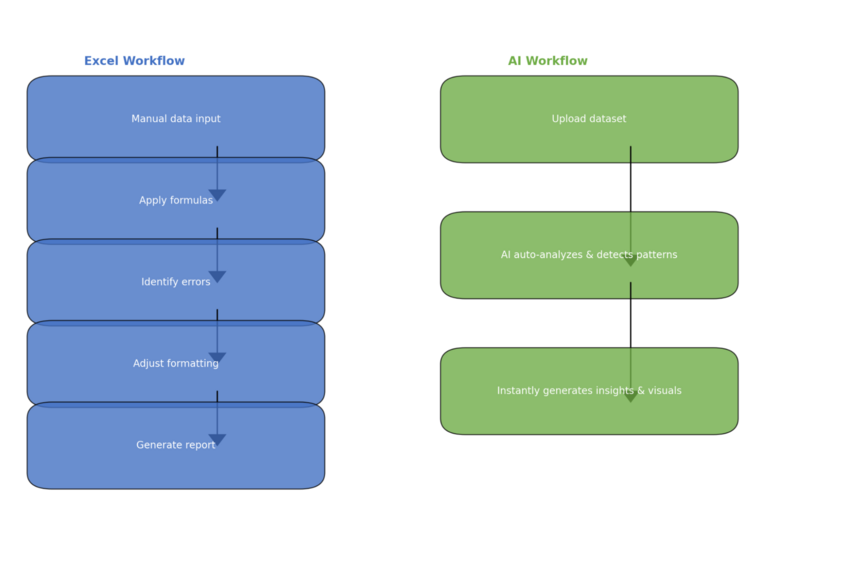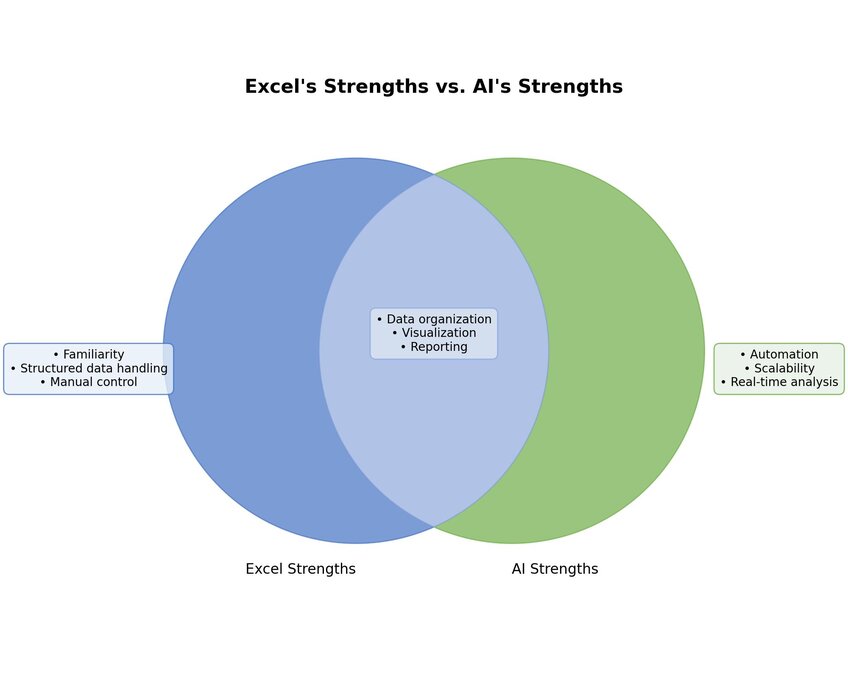April 23rd, 2025
AI vs. Excel Guide: Will AI Replace Excel and More to Consider
By Connor Martin · 8 min read

As artificial intelligence (AI) becomes a bigger and more influential part of the modern world, there is much debate and discussion about the many roles it might take on and the people, apps, and platforms it could replace.
Given AI’s abilities in data analysis, for example, and its capacities to create charts, calculate complex formulas, and identify trends, could it someday replace traditional data management tools like Microsoft Excel?
This guide aims to answer that question, pitting AI vs. Excel to see how the two compare.
Key Takeaways
• AI enhances, not replaces, Excel: While AI automates data analysis, reduces errors, and improves scalability, Excel remains widely used for structured data management and business processes.
• AI is superior for large-scale data tasks: AI-driven tools handle massive datasets, provide real-time insights, and generate advanced visualizations far more efficiently than Excel.
• Excel is evolving with AI features: Microsoft has integrated AI-powered tools like Co-Pilot into Excel, but many businesses are also turning to standalone AI platforms for deeper analytics and automation.
Understanding Excel’s Role in Data Management
Excel was launched in 1982. Since then, decade after decade, it has consistently remained the go-to choice in the business world for spreadsheet management and complex data analysis. Organizations of all sizes have used Excel over the years to store, analyze, interpret, and visualize datasets in numerous forms.
Customer data, employee information, and sales figures – all are easily inputted into Excel spreadsheets, with numerous functions and formulas available to identify market trends, track patterns, and derive insights.
It’s also useful for forecasting, budgeting, generating reports, and so much more. These many features have made Excel an indispensable, invaluable element of many a tech stack, trusted by an enormous amount of users.
Why Excel Remains a Powerful Tool
Excel has an enduring presence in business, finance, and analytics. Even as new technologies emerge, Excel remains a trusted solution for handling structured data efficiently. Here are a few reasons why Excel is still very powerful:
• Familiarity: As touched on above, Excel has been around for decades. People have grown up using this tool. It’s the go-to choice in spreadsheet software for users of different ages, backgrounds, and professions who have become familiar with its menus, functions, and capacities.
• Versatility: From data cleaning to the analysis of large datasets, creating easy-to-understand charts and visualizations, and even rudimentary predictive analytics, Excel has a vast variety of uses. It’s helpful for marketers, manufacturers, retail businesses, and many others.
• Accessibility: While it certainly has a wide range of complex data analysis capabilities and functions that are useful to more advanced users, Excel remains a highly accessible application. New users can learn the basics quite quickly and use Excel to save time on repetitive tasks.
• Updates and Improvements: As with other apps in the Microsoft Office catalog, Excel has been regularly updated and improved to remain relevant to modern spreadsheet uses. Recent updates have even introduced AI in Excel, courtesy of Microsoft’s Co-pilot model.
Thanks to all this, even now, as we progress further into the age of AI, this tool is still useful and relevant. Countless businesses continue to rely on it daily, and that is likely to remain the case for quite some time.
Excel Limitations In a Data-Focused World
While Excel’s longevity and its continued usefulness are impressive, its limitations are starting to become obvious. This is especially true in today’s world, where companies seem to have larger and more diverse data sets to store, manage, and analyze.
For example, despite its helpful time-saving formulas, plus its import and export functions, Excel still relies heavily on manual data input. Users have to insert data, one bit at a time. Manual practices like these are always prone to human errors and oversights.
When handling big quantities of data, even a seemingly small, simple mistake can jeopardize the entire data set, and any possible data analysis process, too. It’s also a time-consuming, resource-draining procedure, and Excel users need a higher level of expertise to use the more advanced formulas to full effect.
At least in its current iteration, Excel also struggles to handle increasingly bigger data sets, often suffering performance issues or even crashes. Plus, it lacks the ability to update and analyze data in real-time and is increasingly bypassed by businesses in favor of more advanced analytical apps.

How AI Is Transforming Spreadsheet Management
AI tools are changing the game of spreadsheet management, introducing faster, more efficient, and more precise ways to store, work with, and analyze large datasets. Here are just some examples of the benefits and new features AI brings:
• Automation: AI can do a lot of things on its own, with only minimal manual intervention. It can take sales data from one source, for example, and create spreadsheets, tables, and visualizations all on its own, easing the burden on individual workers and teams.
• Advanced Analysis: Though Excel can perform complex analysis of data, AI brings far more advanced, comprehensive analysis capacities. It can scan vast quantities of data to spot patterns and derive insights and offers unparalleled capacities in predictive analysis to discern future trends.
• Data Organization: AI helps organizations manage their data more efficiently and smartly. It can help with data retrieval and data categorization, for instance, aiding users in finding specific bits of data more easily and conveniently.
Comparing AI vs. Excel: Key Differences
AI takes a totally different approach to data and spreadsheet management, putting it in stark contrast to Microsoft Excel in key areas, like:
• Data Input
• Analysis
• Error Handling
• Scalability
• Accessibility
Data Input
With Excel, data input is a mostly manual process. Users have to either import data from other sources, which can sometimes cause compatibility issues, or physically type figures into spreadsheet cells, one by one. AI tools have a much more intuitive approach. Users can often merely upload a file – various formats are supported – and AI will extract the data.
Analysis
As touched on earlier, AI tools typically offer far more advanced and capable analytical features than Excel. You can use certain formulas in Excel to generate reports or derive insights from data. But AI goes much further, capable of carrying out complex analytical procedures in response to simple user prompts.
Error Handling
Given that AI does much more work on its own, without the need for human intervention, there’s a much lower risk of errors and oversights when you’re using AI. In contrast, when manually entering data, formulas, and functions into Excel spreadsheets, it’s easy for errors to go unnoticed or result in function fail states.
Scalability
An issue with Excel touched on earlier, is that it struggles with very large data sets. This limits its scalability, as once you start dealing with data in certain quantities, Excel becomes less reliable. It can freeze, crash, and suffer other issues. AI has fewer limitations. In theory, this technology is highly scalable.
Accessibility
Excel has been praised for its accessibility, and rightfully so. But, in many ways, AI tools are even more accessible and beginner-friendly, as they take so much of the complexity and confusion out of data management and analysis. The best AI data analysis tools, like Julius AI, do the hard work for you, allowing even beginners to dig into data like never before.

Will AI Replace Excel?
In the short term, it’s not likely we’ll see AI utterly replace Excel. There’s still room for both of these technologies to co-exist, and many organizations will surely find that integrating Excel and AI, rather than picking one over the other, will be the best way forward.
Here’s a closer look at why that is.
Where AI Excels Beyond Excel
AI is superior to Excel in aspects like accessibility, analytical potential, and when dealing with large amounts of data. It’s great for creating visualizations in an instant, and superior at organizing data in neat, structured, logical ways.
With that said, there is still a learning curve to this technology, and it will take time for teams to master AI and discover the best ways to use it for their specific data needs.
Why Excel Will Likely Still Be Relevant
Despite the advantages AI and natural language processing technology have over Excel, it will remain relevant for a while to come. This is largely due to the aforementioned familiarity factor – AI is still new tech that people will need to get used to, while Excel is ingrained in business culture and a cornerstone of many tech stacks. Plus, Excel is receiving its own AI upgrades to improve functionality.
Should You Switch to AI for Spreadsheet Management—Among Other Things?
So, is now the time right to turn to AI to store your historical data, identify market trends, and more? Well, there are certainly arguments in favor of AI vs. Excel. At the same time, as explained earlier, there is also still a place for Microsoft’s classic application. Ultimately, the two will probably be used in unison with each other to achieve the best results.
When AI Is the Better Choice
AI is the superior option when:
• Working with very large amounts of data
• Carrying out detailed or difficult analysis
• Creating visualizations – charts, tables, graphs, etc.
• Future-proofing your firm and embracing emerging technologies
When Excel Remains the Best Option
There are still situations where it’s best to use Excel, such as:
• When carrying out simpler data management tasks
• Working with relatively small data sets
• Teams that are not yet familiar with or trained in AI
The Future of AI and Excel
In the future, as AI improves, it’s likely that more users will drift away from Excel and towards alternative AI platforms that take its place. We are also likely to see more Excel AI tools and features added to Microsoft’s program in a bid to bridge that gap between Excel and AI. Whether that proves enough for Excel to remain relevant in an increasingly AI-dominant world remains to be seen.
Discover Firsthand How AI Can Be Easier and More Helpful than Excel. Try Julius AI Today
While there is still room for Excel in today’s world, AI is clearly going to play a bigger role in aspects like spreadsheets and data management as time goes by.
You can experience the benefits firsthand and see just how much more efficient and easy-to-use AI is than Excel today by trying Julius AI, the only AI data analyst assistant you’ll ever need.
Frequently Asked Questions (FAQs)
Does Excel have AI now?
Yes, Microsoft has integrated AI into Excel with tools like Co-Pilot, which helps with data analysis, trend detection, and formula suggestions. While these features enhance efficiency, many users are also turning to standalone AI tools for more advanced automation, deeper insights, and greater flexibility beyond Excel’s built-in capabilities.
Can AI summarize an Excel spreadsheet?
Yes, AI can scan spreadsheets, extract key insights, and generate summaries or visualizations. This helps users quickly interpret data without manual analysis.
Can AI replace Microsoft Excel?
AI can outperform Excel in automation, predictive analytics, and error reduction, but Excel remains widely used and deeply embedded in business processes. Instead of replacing Excel, AI is more likely to enhance it, improving efficiency and decision-making.
What will replace Excel in the future?
AI-driven data tools are increasingly handling tasks where Excel falls short, such as automation and large-scale analytics. While Excel will likely evolve with AI enhancements, businesses may gradually shift toward more advanced, real-time solutions.
